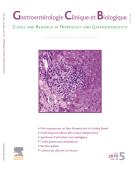Pancreatic changes in TNBS-induced colitis in mice - 06/05/08
Marc Barthet [1],
Laurent Dubucquoy [4],
Stéphane Garcia [2],
Mohamed Gasmi [1],
Pierre Desreumaux [4],
Jean-Frédéric Colombel [4],
Jean-Charles Grimaud [3],
Juan Iovanna [1],
Jean-Charles Dagorn [1]
Mostrare le affiliazioniBackground and aim |
Recent clinical data suggest that pancreatitis could be an extraintestinal manifestation of inflammatory bowel disease. However, no experimental data support such a clinical relationship. The aim of this study was to investigate the presence of pancreatic damages in mice with TNBS-induced colitis.
Methods |
Colitis was induced in Balb/C mice by intrarectal instillation of TNBS. Control mice received either intrarectal instillation of NaCl saline solution or 50% ethanol. Presence of colitis was assessed by macroscopic and microscopic examination, extent of mucosal damage being evaluated by the scoring systems of Wallace and Ameho in 8 mice with TNBS-induced colitis and in 4 controls. Pancreatic samples from the same mice underwent morphological examination after standard coloration. Intrapancreatic expression of the pancreatitis-associated protein (PAP), a marker of pancreatic inflammation, was monitored by automated immunohistochemistry using specific antibodies. In addition, quantification of TNFα mRNA by competitive PCR and semi-quantification of PAP, IL-10 and IL-1β mRNAs were performed on pancreas in 10 mice with TNBS-induced colitis and in 10 control mice.
Results |
All mice treated with TNBS and none of the controls had colitis. Macroscopic and microscopic examination of the pancreas of the 4 control mice was normal, whereas in 5 out of the 8 TNBS-treated mice histological changes were observed, with inflammatory infiltrate and fibrin aggregates at the periphery of the gland. PAP immunohistochemistry was negative in all control mice and positive in all mice with TNBS-induced colitis, with a patchy distribution of staining. PAP immunolocalized to the cytoplasm of acinar cells, duct cells and islets of Langherans being negative. PAP and IL-1β mRNA levels in the pancreas were significantly increased but the increase in TNFα mRNA level did not reach statistical significance (P = 0.06). IL-10 mRNA levels did not show any significant modification.
Conclusion |
PAP overexpression in pancreas demonstrates that inflammatory stress early occurs in the mouse pancreas during the course of TNBS-induced colitis. The concomitant pancreatic overexpression of IL-1β and, to a lesser extent, of TNFα, two proinflammatory cytokines also associated with the intestinal lesions of colitis, supported a pancreatic inflammatory mechanism mediated by cytokines.
Mappa
© 2003 Elsevier Masson SAS. Tous droits réservés.
Vol 27 - N° 10
P. 895-900 - Ottobre 2003 Ritorno al numeroBenvenuto su EM|consulte, il riferimento dei professionisti della salute.

